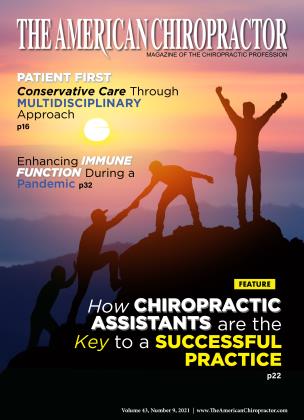As the third-largest healing profession in the United States, chiropractic is being pushed to the forefront of the short and long-term management of spine pain. In a recent paper by George, Lentz, and Goertz (2021) from the Department of Orthopedic Surgery and Duke Clinical Research Institute, the authors discussed support of routine delivery of nonpharmacological treatments as a way to improve individual and population health. The authors stated, “Recent clinical practice guidelines recommend the use of nonpharmacologic treatments to decrease pain and improve physical function for individuals with back and neck pain.” (p. 1)
The paper continued by outlining, “In fact, back and neck pain accounted for $134.5 billion of U.S. healthcare spending in 2016. This was the highest healthcare spending for any of the 154 medical conditions included in the study, led by private insurance (57.2%), then public insurance (33.2%), and out-of-pocket payments (9.2%).” (p. 1) The paper further stated, “For decades, usual medical care for spine pain (whether an acute or chronic condition) has focused on standard treatments and technologies prescribed by primary care providers or procedures that require referral. Recently the effectiveness of this medically driven approach has been questioned in the literature.” (p. 1)
It is important to note that a much larger national discussion is occurring in scientific literature relating to chronic spine care. The focus is on moving toward a model of “management” as opposed to a “curative” model. Most other human ailments, particularly internal medicine disorders, are not cured; they are managed. True cost savings coupled with better overall outcomes can only be achieved with this shift in the healthcare mindset.
The paper continued by stating that “many existing healthcare systems have been designed to consider pharmacologic treatments to be primary interventions, while considering conservative treatments as secondary interventions that are made available only to those who fail primary treatments.” (p. 2) The authors suggested, based on the scientific literature, “After nonpharmacologic treatments are trialed, secondary treatments, such as pharmacologic, interventional, and surgical treatments, would be considered in a stepped, progressive manner for those still experiencing symptoms. Structuring care in this manner has been successfully piloted, demonstrating that first contact with a nonpharmacologic provider (i.e., physical therapist, chiropractor, or acupuncturist) can result in less opioid use when compared to the first contact with a primary care physician provider.” (p. 3)
When discussing a change in healthcare modeling for the spine, a major caveat appears to be overlooked. That caveat is that the healthcare system cannot expect primary care medical physicians to “manage” these spine cases because they are overwhelmed already. We need a healthcare provider who can practice under a license that provides autonomy to accept patients directly, order diagnostic testing, refer to other providers for consultation, and has the education to properly support that management with diagnostic skill, interprofessional communication, and a robust documentation sharing system. That provider would carry the title of “spine management physician” and would provide a unique perspective on spine patient care. We suggest that the provider be a board-certified doctor of chiropractic with additional and specialized interprofessional training. Working with a trained doctor of chiropractic will assist local practices and the national healthcare system by reducing unnecessary procedures while providing a patient-centered management approach that encourages early diagnosis and management of spine pain. In the end, the chiropractic profession is best suited to fill that role.
Dr. William Owens Jr. is currently in private practice in Buffalo, NY. His practice employs 4 Doctors of Chiropractic and 2 Physical Therapists. He is President and CEO of the National Spine Management Group, LLC and Clinical Director of the Fellowship in Spinal Biomechanics and Trauma. Additionally, Dr. Owens is Adjunct Faculty in Family Medicine at the State University of New York at Buffalo Jacobs School of Medicine. He can be reached at 716.228.3847.
Reference
1. George, S. Z, Lentz, T. A., & Goertz, C. M. (2021). Back and neck pain: in support of routine delivery of non-pharmacologic treatments as a way to improve individual and population health. Translational Research
 View Full Issue
View Full Issue






